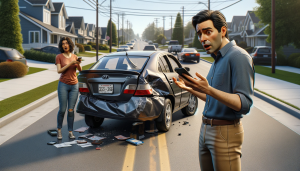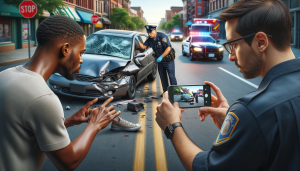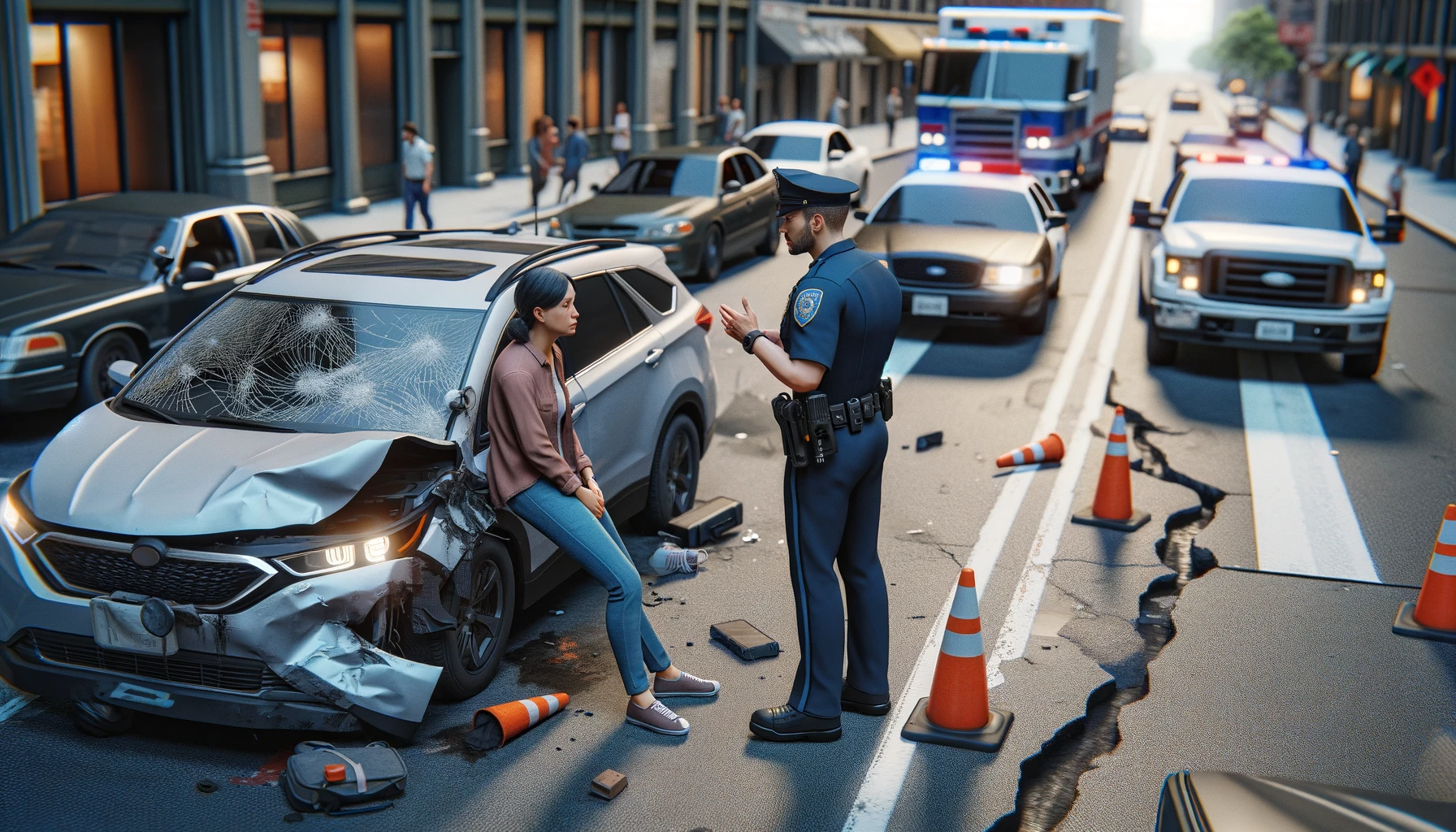Traffic accidents, otherwise known as motor vehicle collisions (MVCs), usually occur when a vehicle collides with another vehicle, pedestrian, animal, road debris, or other stationary obstruction. These incidents can result in
Injury, property damage and even death.

In determining the guilty party in any traffic accident, the main factor considered is negligence. In legal terms, negligence refers to the failure to behave with the level of care that someone of ordinary prudence would have exercised under the same circumstances. If a driver fails to pay attention to the road, for instance, and collides with another car, their negligence would automatically make them at fault.
Factoring In Traffic Laws
Understanding traffic laws is also essential to understand
Traffic accidents. Traffic laws, which may vary by city, state, or country, govern the operation of vehicles and the use of roads. Violation of these laws, such as speeding, not using turn signals, or running red lights, often contribute to accidents and play a significant role in determining who is at fault.
Sometimes, it isn't just the drivers' actions that cause
Traffic accidents but also environmental factors. Poor weather conditions, like heavy rain, snow, or fog, can contribute to accidents by reducing visibility and making the roads slick. Similarly, the design and condition of the road itself can be a contributing factor in some accidents.
Role of Insurance Companies and Legal Professionals
Lastly, understanding
Traffic accidents also involves knowing how insurance companies and legal professionals come into play. After an accident, both parties' insurance companies investigate the incident to ascertain fault. They look at evidence such as police reports, witness testimony, and damage at the scene. In some cases, legal professionals may also get involved, especially if the accident results in significant
Injury or property damage.
The Role of Traffic Laws
Understanding Traffic Laws
Traffic laws have been established to maintain order and promote safety on the roads. These rules govern the operation and movement of vehicles and pedestrians, setting standard procedures to minimize accidents and ensure smooth traffic flow. Violations of these laws play a significant role in determining the guilty party in the event of a road mishap.
Violation of Traffic Laws: A Key Consideration
When an accident occurs, the first step is to identify if either party has violated any traffic laws. This could range from speeding and running red lights, to not giving right of way or reckless driving. If it's determined that a driver has broken a law leading to the accident, that driver is likely to be considered at fault.
Role of Witnesses and Evidence Collection
Evidence from the scene, including witness testimony, are crucial to determine whether traffic laws were broken. Traffic cameras, dashcams, and bystander videos can often provide clear evidence of law violations. Police reports also contain important information about the circumstances surrounding the accident, contributing to the assessment of guilt.
Impact of Local Regulations
Traffic laws can vary by state or country, impacting how fault is determined. Some jurisdictions follow a 'no-fault' system where each party's insurance pays for their losses regardless of who caused the accident. Others operate under tort law, where the guilty party is liable for damages. Understanding local traffic laws is therefore crucial.
Consideration of Multiple Faults
In some cases, both parties may have violated traffic laws leading to the accident. Here, principles like comparative or contributory negligence come into play. This means the fault is shared between parties based on their percentage of responsibility, again highlighting the role of traffic laws in accident situations.
Assessing Accident Scenes
Initial On-Site Evaluation
The first step in assessing an accident scene is the initial on-site evaluation. This involves taking a general look at the accident site, including the position and condition of the vehicles, the presence of skid marks, and any traffic signs or signals. Any obvious evidence, such as broken glass or vehicle parts, should also be noted down. This initial evaluation provides a broad overview of what occurred during the
Traffic accident.
Documenting the Accident Scene
After conducting an initial assessment, the next step in evaluating an accident scene is to document it thoroughly. This can involve taking photographs or videos of the scene, the vehicles involved, and any visible injuries. It's also important to draw a sketch or diagram of the accident scene, showing the positions of the vehicles before, during, and after the collision. All these pieces of documentation will serve as a visual record of the accident, which can help in later analysis and investigation.
Gathering Witnesses' Statements
Another critical part of assessing an accident scene is collecting statements from witnesses. Witnesses can provide a third-party perspective on what happened, which can be crucial in determining the guilty party in a
Traffic accident. When gathering witness statements, it's important to ask thorough and unbiased questions to get a clear and accurate understanding of events.
Determining Violations of Traffic Laws
Inspecting for violations of traffic laws plays a significant role in determining the guilty party in a
Traffic accident. Was one driver speeding, or did another run a red light? Understanding if any laws were broken at the time of the accident can point towards who was at fault.
Seeking Professional Expertise
In more complex situations where the cause of the accident is not clear, professional expertise may be needed. Accident reconstruction experts can use the data collected from the scene, vehicles, and witness reports to determine what led to the collision. Their analysis can provide a more in-depth understanding of the accident, helping to identify who was responsible.
Importance of Witness Statements
Providing Firsthand Accounts
Witness statements are invaluable in offering firsthand accounts of
Traffic accidents. These testimonies outline the circumstances and events that transpired leading to the accident, during, and after the accident. They serve as critical pieces of evidence that validate the authenticity of one's account, especially when there is confusion or discrepancies between involved parties.
Corroborating Evidence
Equally vital in determining the guilty party in a
Traffic accident, witness statements often act as corroborating evidence. They can provide additional perspectives and possibly confirm the victim's narrative of events. In situations where physical evidence might be inconclusive or absent, such corroborative information becomes an essential determinant in establishing guilt.
Identifying Likely Culpability
In circumstances where both drivers refute blame, the importance of witness statements rises dramatically. Independent witnesses who have no material or emotional interest in the outcome can offer unbiased accounts, helping arbitrate between conflicting stories. Their testimony can highlight inconsistencies in the reports of the individuals involved in the accident, pointing out likely culpability.
Supporting Legal Processes
Witness statements also play a crucial part in the legal processes that follow
Traffic accidents. They can aid law enforcement officers in their investigations, helping them piece together the most accurate picture of what occurred. Additionally, these statements can guide insurance companies in determining responsibility and payout amounts, potentially influencing the outcome significantly.
Instilling Transparency and Fairness
Finally, witness statements contribute to the overarching goal of instilling transparency and fairness in
Traffic accident cases. Their inclusion in the investigative process ensures that each party has a fair chance to present their case, helping adjudicators arrive at informed, impartial decisions. Without witness statements, it would be considerably more challenging to determine the truth and assign responsibility accurately.
Role of Police Reports in Determining Fault
Function of Police Reports in Fault Assessment
Police reports play a critical role in determining who is at fault in a
Traffic accident. The main function of these reports is to provide a standardized, objective account of the incident. These documents, authored by the responding law enforcement officers, detail the circumstances surrounding the accident, including the location, weather conditions, and time of the event. They may also contain diagrams of the accident scene and statements from involved parties and witnesses. This objective information can be highly useful in pinpointing responsibility.
Police Opinion on Fault Determination
It's important to note that police reports often include the officer's personal perspective on who was at fault in the accident. Officers determine this based on their professional understanding of the traffic laws and their analysis of the physical evidence at the scene. This aspect of the police report can greatly influence the decision-making process of insurance companies and courts when assigning blame.
The Influence of Violations and Citations
The presence of traffic violations or citations in the police report can be a major factor in determining fault. If a driver is cited for a traffic infraction related to the accident, such as speeding or running a red light, this violation will often be interpreted as an indication of fault. Insurance companies pay close attention to this information in the report, and it can heavily influence their assessment.
Role of Police Reports in Legal Proceedings
Outside of insurance claim contexts, police reports are generally not admissible as evidence in court due to hearsay rules. However, they still play a significant role in legal proceedings surrounding traffic accidents. Attorneys frequently use these reports during their investigations to understand the accident scenario and establish a strategy for the case. Moreover, if a case goes to trial, the testifying officer may rely on their report to jog their memory about the incident's details.
Efficacy and Limitations of Police Reports
While police reports are an essential tool in attributing fault in a
Traffic accident, they are not infallible. Mistakes can be made and important details overlooked or misinterpreted. Additionally, since officers were not actually witnesses to the accident, their conclusions are based on post-event analyses. Regardless of these potential shortcomings, the police report remains a valuable piece of the puzzle in determining who is responsible for a traffic incident.
Impact of Traffic Camera Footage
Evidential Value of Traffic Camera Footage
Traffic camera footage can serve as critical evidence when determining who is at fault in a
Traffic accident. They record various aspects of road conditions, traffic flow, and driver behavior that can help to establish the circumstances leading up to the accident. The footage can offer objective details such as speed, direction, and timing which can clearly indicate who violated traffic rules or was otherwise reckless.
The Role of Traffic Cameras in Investigating Accidents
Traffic cameras often play a role in investigating accidents. They can capture high-quality video footage that can be used to recreated the scene of an accident in detail. Law enforcement agencies and insurance companies often rely on this footage to establish the sequence of events, make accurate assessments and form judgments about liability.
Legal Considerations of Traffic Camera Footage
The usage of traffic camera footage as evidence in court cases also has various legal considerations. Judicial bodies typically require the footage to be authenticated as a true and accurate representation of the incident. The utilization of traffic camera footage also falls under privacy laws and regulations, a factor that may affect its admissibility in some jurisdictions.
Limitations of Traffic Camera Footage
While traffic camera footage can be highly beneficial, it also has its limitations. Not all areas are monitored by traffic cameras, and even if a camera is present, it may not have captured the accident due to its field of view or technical issues. Moreover, the clarity and quality of the footage can vary, potentially limiting its usefulness.
Corroboration with Other Evidence
Traffic camera footage rarely tells the full story of a traffic accident on its own. It is typically used in conjunction with other forms of evidence such as eyewitness testimonies, physical evidence from the accident scene, and expert analysis. This comprehensive approach can provide a fuller picture of the incident, leading to a fair and accurate determination of guilt.
Legal Processes in Traffic Accident Disputations
Investigating the Accident
The investigation of a traffic accident generally begins at the scene. Law enforcement agencies are typically involved to investigate the accident, gather evidence, take testimonials, and create an official accident report. This report often becomes a vital piece of evidence in subsequent legal proceedings, as it may include details about the circumstances surrounding the accident, such as weather conditions, traffic signals, and eyewitness accounts.

The Role of Insurance Companies
Insurance companies play a significant part in determining the liable party after a traffic accident. After notifying their respective insurance companies of the incident, both parties' insurers conduct their independent investigations. These investigations often parallel law enforcement's findings but can also reveal additional information. They assess the damages, determine the degree of fault for each party based on evidence, rules of the road, and local laws, which can significantly impact claim settlements.
Litigation and Traffic Court Proceedings
If liability isn't clearly established or if the dispute can't be resolved through insurance claims, then the case might proceed to traffic court. Here, both parties, typically represented by legal counsel, present their evidence before a judge or jury. At the outset of the trial, pleadings are exchanged, followed by the discovery process where each side gathers evidence. The judge or jury then carefully examines the evidence to determine the degrees of responsibility of each party.
Usage of Expert Witnesses
In some cases, expert witnesses are brought in to provide additional insight into the specific circumstances of the accident. These experts can range from accident reconstruction experts, who can provide a detailed analysis of how and why the accident occurred, to medical specialists who can testify about the extent and cause of injuries. The testimony of these experts can hold substantial sway in court proceedings.
Appealing a Decision
The conclusion of a trial does not always mark the end of legal processes in traffic accident disputations. If a party believes that there has been a legal error during their trial, they may choose to appeal the decision. The appeals process involves another court reviewing the findings and conclusions of the original trial and is often a complex and time-consuming process. It's important for any party considering an appeal to consult with a specialist attorney to understand the implications fully.
Conclusion
In the intricate aftermath of a traffic accident, pinpointing fault resembles unraveling a multifaceted puzzle. It's a meticulous procedure entailing legal scrutiny, examination of evidence, and frequently, integration of technological resources. Familiarizing yourself with the mechanics of this process can empower you to traverse the frequently daunting journey towards resolution. Keep in mind, the journey towards establishing fault commences with unwavering commitment to truth and culminates in the dispensation of justice.
Look for an attorney who has the right legal resources for your legal needs.
Contact us here on the
Warmuth Law website or through our hotline 888-517-9888.
Frequently Asked Questions (FAQ's)
1. What is the first step in determining fault after a Car accident?
In the immediate aftermath of a
Car accident, amidst the chaos, the primary step towards establishing fault typically involves gathering evidence at the scene. This encompasses tasks such as capturing photographs of the vehicles' positions, documenting any visible damages, and securing statements from witnesses. Maintaining composure during this process is crucial, as it enables individuals to gather as much pertinent information as possible, which in turn aids in the subsequent fault determination procedures.
2. Can witness statements significantly impact the determination of fault?
Certainly, witness statements wield considerable influence in the determination of fault. Offering an impartial viewpoint, these third-party accounts serve to either corroborate or challenge the narratives put forth by the involved drivers. Witnesses often contribute invaluable insights that help to bridge informational gaps and elucidate crucial details, thereby emerging as invaluable assets in the fault determination endeavor.
3. How do insurance companies investigate and determine fault in traffic accidents?
Insurance companies employ their cadre of adjusters who undertake meticulous investigations following a traffic accident. Their investigative process encompasses a comprehensive review of police reports, conducting interviews with drivers and witnesses, scrutinizing photographic and video evidence, and occasionally employing forensic analysis and accident reconstruction techniques. The overarching objective is to construct a comprehensive narrative of the incident, facilitating a clear determination of liability.
4. What role do police reports play in establishing who is at fault in a Car Accidents?
Police reports serve a pivotal function in the establishment of fault following a
Car accident. Responding officers meticulously document their observations, gather statements from involved parties and witnesses, and in some instances, proffer a preliminary assessment of fault. While not absolute, these reports carry substantial weight in the eyes of both insurance companies and courts, significantly shaping the final determination of responsibility.
5. What happens if both parties involved in a traffic accident are found to be at fault?
In scenarios where both parties bear some degree of responsibility, the principle of comparative negligence becomes operative. This legal doctrine entails apportioning fault among the involved parties based on their respective contributions to the accident. Consequently, each driver's liability is evaluated proportionally, a factor that may impact the extent of compensation they are entitled to or liable for, thus ensuring a fair and equitable resolution.













